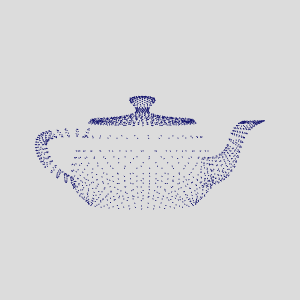ReadTextFile
vtk-examples/Cxx/IO/ReadTextFile
Description¶
This example takes a plain text file of coordinates and reads them into a vtkPoints, which is then put into a vtkPolyData and displayed on the screen using a vtkVertexGlyphFilter.
An example file may look like: 1 2 3 4 5 6 7 8 9
Note
for a simpler way to read such a file, see SimplePointsReader.
Question
If you have a question about this example, please use the VTK Discourse Forum
Code¶
ReadTextFile.cxx
#include <vtkActor.h>
#include <vtkNamedColors.h>
#include <vtkNew.h>
#include <vtkPoints.h>
#include <vtkPolyDataMapper.h>
#include <vtkProperty.h>
#include <vtkRenderWindow.h>
#include <vtkRenderWindowInteractor.h>
#include <vtkRenderer.h>
#include <vtkVertexGlyphFilter.h>
#include <sstream>
int main(int argc, char* argv[])
{
vtkNew<vtkNamedColors> colors;
// Verify input arguments
if (argc != 2)
{
std::cout << "Usage: " << argv[0] << " Filename(.txt) e.g. TeapotPoints.txt"
<< std::endl;
return EXIT_FAILURE;
}
// Get all data from the file
std::string filename = argv[1];
std::ifstream filestream(filename.c_str());
std::string line;
vtkNew<vtkPoints> points;
while (std::getline(filestream, line))
{
double x, y, z;
std::stringstream linestream;
linestream << line;
linestream >> x >> y >> z;
points->InsertNextPoint(x, y, z);
}
filestream.close();
vtkNew<vtkPolyData> polyData;
polyData->SetPoints(points);
vtkNew<vtkVertexGlyphFilter> glyphFilter;
glyphFilter->SetInputData(polyData);
glyphFilter->Update();
// Visualize
vtkNew<vtkPolyDataMapper> mapper;
mapper->SetInputConnection(glyphFilter->GetOutputPort());
vtkNew<vtkActor> actor;
actor->SetMapper(mapper);
actor->GetProperty()->SetColor(colors->GetColor3d("MidnightBlue").GetData());
vtkNew<vtkRenderer> renderer;
renderer->AddActor(actor);
renderer->SetBackground(colors->GetColor3d("Gainsboro").GetData());
vtkNew<vtkRenderWindow> renderWindow;
renderWindow->AddRenderer(renderer);
renderWindow->SetWindowName("ReadTextFile");
vtkNew<vtkRenderWindowInteractor> renderWindowInteractor;
renderWindowInteractor->SetRenderWindow(renderWindow);
renderWindow->Render();
renderWindowInteractor->Start();
return EXIT_SUCCESS;
}
CMakeLists.txt¶
cmake_minimum_required(VERSION 3.12 FATAL_ERROR)
project(ReadTextFile)
find_package(VTK COMPONENTS
CommonColor
CommonCore
FiltersGeneral
InteractionStyle
RenderingContextOpenGL2
RenderingCore
RenderingFreeType
RenderingGL2PSOpenGL2
RenderingOpenGL2
)
if (NOT VTK_FOUND)
message(FATAL_ERROR "ReadTextFile: Unable to find the VTK build folder.")
endif()
# Prevent a "command line is too long" failure in Windows.
set(CMAKE_NINJA_FORCE_RESPONSE_FILE "ON" CACHE BOOL "Force Ninja to use response files.")
add_executable(ReadTextFile MACOSX_BUNDLE ReadTextFile.cxx )
target_link_libraries(ReadTextFile PRIVATE ${VTK_LIBRARIES}
)
# vtk_module_autoinit is needed
vtk_module_autoinit(
TARGETS ReadTextFile
MODULES ${VTK_LIBRARIES}
)
Download and Build ReadTextFile¶
Click here to download ReadTextFile and its CMakeLists.txt file. Once the tarball ReadTextFile.tar has been downloaded and extracted,
cd ReadTextFile/build
If VTK is installed:
cmake ..
If VTK is not installed but compiled on your system, you will need to specify the path to your VTK build:
cmake -DVTK_DIR:PATH=/home/me/vtk_build ..
Build the project:
make
and run it:
./ReadTextFile
WINDOWS USERS
Be sure to add the VTK bin directory to your path. This will resolve the VTK dll's at run time.
